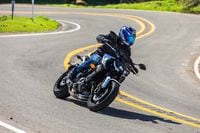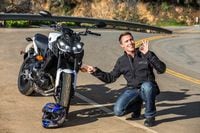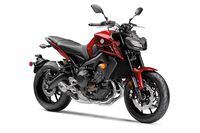Today was a good day. Any day I get to spend riding motorcycles is a good one, but today I rode some of the best roads in Southern California on one of the best bikes in the naked middleweight category. The FZ-09 has already been a huge success for Yamaha, and for 2017 the bike is even better. Much better.
Racing down Latigo Canyon Road toward Malibu and the fog-covered Pacific Ocean, I‘m struck by how improved this new FZ-09 is. I spent nearly 10,000 miles on a first-year (2014) FZ-09, and even after $2,000 in carefully chosen upgrades my project bike wasn’t this good. In fact, I always rode up Latigo on my FZ, because the front-end feel was never good enough for me to enjoy the downhill run.
Now, however, I’m charging downhill and trail braking deep into corners and loading the front tire like I’m on a sportbike. Mid-corner the bike feels planted and stable, and throttle pickup is smooth and predictable. The FZ-09 still isn’t perfect, but the 2017 bike is leaps and bounds better than what I ended up with after a year of development. In part I’m disappointed that my efforts weren’t more successful, but deep down I’m just happy—happy that Yamaha finally got the FZ-09 right. This bike is a hell of a lot of fun to ride.
The original FZ-09 was a huge hit thanks to it’s feisty three-cylinder engine, crazy light weight and nimble handling, and accessible eight-grand price tag. But that low price came at a cost—namely sloppy soft suspension and terrible throttle response. Those two flaws exacerbated each other and could make the Yamaha frustrating and difficult to ride.
For 2017 the FZ-09 underwent an overhaul, and besides giving the bike a major makeover to make it look more like its big brother the FZ-10, Yamaha also addressed the FZ’s suspension and throttle-response issues. It’s got a reworked fork that’s fully adjustable and revised throttle mapping (the same programming as the XSR900 and FJ-09), plus an assist-and-slip clutch, three-level traction control, ABS, and more.
Far and away the biggest improvement is the fork. Previously it only had one damping cartridge in the left leg, and there was no way to get that one assembly to properly manage both high- and low-speed compression and rebound damping. That’s why my rebuilt fork still felt vague at full lean. Now, with the addition of a dedicated compression cartridge in the left fork leg, the circuits are separate and do a much better job of controlling chassis movement.
During my test ride in the Santa Monica Mountains I thought the front-end feel was excellent, and I didn’t see a need to stray from the stock fork settings. The more composed front end was better on the brakes, better at full lean, and much better during quick left-right transitions. That being said, the shock is the same flaccid unit as before, though adding a step of preload and a quarter-turn of rebound damping helped keep it from wallowing in faster corners and brought it into balance with the firmer front end. Of course there is still room for improvement, but overall I’m really happy with the FZ’s chassis, and it’s up to the task of all but the most aggressive street riding unless you’re a heavier (180 pounds or more) rider. If you’re in the 130 to 160-pound range, I think the stock suspension is going to be a great fit for you.
The engine is the same as before, and that’s a good thing. I’ve loved the motor since the first time I heard it growl its raspy song. You’ll never want for thrust with this 847cc triple, and it delivers character by the bucketful. What’s new is the way the engine responds to throttle movements. It’s calmer, smoother, and more predictable than my 2014 project bike, even after I’d had the ECU reflashed. Throttle response still isn’t as silky smooth as on Triumph’s triples (the benchmark for the industry, in my opinion), but instead of being a major issue it’s now just a minor annoyance, and one you quickly adapt to.
The ergos are the same as before, too, though the seat sits a bit higher and is more solidly mounted to the subframe. My '14 FZ's seat was loose and slanted forward, so much so that I shimmed it with rubber discs. Now the seat comes that way from the factory, which means a more comfortable riding position and less time spent sliding into the tank.
I could end this write up here and call the 2017 FZ-09 a huge success, but Yamaha didn't stop there, so I won't either. The slip-and-grip clutch is new, and it's the same unit that's used on the XSR900. That means the lever pull is lighter (due to fewer clutch springs) and there's smooth, progressive slipper action during aggressive downshifts. (Don't know why slipper clutches are awesome? Watch this MC Garage video)
I’m also happy to see ABS come standard on the new FZ-09. It’s a great safety feature (though it can’t be turned off), and its importance was made clear when I rounded a bend on Piuma Road just as a pickup truck pulled into my path. Knowing ABS had my back I mashed on the brakes and felt both levers pulse as I slowed. The driver hadn’t even looked in my direction before pulling into the road. This ABS system is fairly lenient, so you can still trail brake aggressively and even endo the bike if you’re smooth enough.
And let’s not forget traction control. That’s new for 2017 as well, and it’s got three levels (including off). As on the FZ-10, level 1 allows power wheelies—the FZ-09’s forte—while still keeping the rear tire from spooling up. I was wheelying out of corners like a mad man, but when I powered across some sand strewn on the road an amber light on the dash flashed and the engine sputtered. That was the TC kicking in. Somehow it lets you have fun while still covering your ass, which I certainly appreciate. Level 2 is highly invasive, and best reserved for wet or slippery conditions.
There’s more to the 2017 update, including cool-blue LED headlights, a swingarm-mounted rear fender, a sleeker tail section with a longer passenger section, a restyled taillight, and a new muffler cover. All told, this was a significant revamp that leaves the FZ-09 vastly improved.
So what’s the drawback? The way I see it, there are only two: weight and price. They’re both up, but only marginally. The MSRP is now $8,999, up about $800 from last year’s model. Curb weight is now listed at 425 pounds, up about 10 pounds from last year. You won’t notice the added heft (which is likely due to the ABS and extra fork internals), but you will notice the smoother throttle response, more balanced suspension, more comfortable seat, brighter headlight, and, if things get slippery, the ABS and TC.
That just leaves the price. Yeah, the 2017 FZ-09 is $809 more than last year’s bike, but you couldn’t build up a previous-model FZ-09 to be this good for twice that figure. Trust me, I tried.











/cloudfront-us-east-1.images.arcpublishing.com/octane/RK3SYNMPH6LTRTFP5XA5ZMHSH4.jpg)








/cloudfront-us-east-1.images.arcpublishing.com/octane/GTCXACQGJ5HAPDTGWUQKDEH44E.jpg)
/cloudfront-us-east-1.images.arcpublishing.com/octane/S35YGSEMEZB4BLTDJTSZPF4GLA.jpg)
/cloudfront-us-east-1.images.arcpublishing.com/octane/5UOT6HPX2JFMRJAX6EH45AR4MQ.jpg)
/cloudfront-us-east-1.images.arcpublishing.com/octane/OKWOJWAKP5EP3OACCRRWPCIX2Q.jpg)
/cloudfront-us-east-1.images.arcpublishing.com/octane/2WF3SCE3NFBQXLDNJM7KMXA45E.jpg)
/cloudfront-us-east-1.images.arcpublishing.com/octane/G4MG6OUCJNBSHIS2MVVOTPX65E.jpg)
/cloudfront-us-east-1.images.arcpublishing.com/octane/IIGGWFOTOJGB7DB6DGBXCCMTDY.jpg)
/cloudfront-us-east-1.images.arcpublishing.com/octane/QSTCM6AVEZA5JJBUXNIQ3DSOF4.jpg)
/cloudfront-us-east-1.images.arcpublishing.com/octane/U4I7G625B5DMLF2DVIJDFZVV6M.jpg)
/cloudfront-us-east-1.images.arcpublishing.com/octane/B6XD6LS6IVCQPIU6HXDJSM3FHY.jpg)
/cloudfront-us-east-1.images.arcpublishing.com/octane/ICL63FEDDRDTTMINYICCEYGMDA.jpg)
/cloudfront-us-east-1.images.arcpublishing.com/octane/FCGZHQXRBZFLBAPC5SDIQLVF4I.jpg)
/cloudfront-us-east-1.images.arcpublishing.com/octane/WNOB6LDOIFFHJKPSVIWDYUGOPM.jpg)

/cloudfront-us-east-1.images.arcpublishing.com/octane/X33NU3E525ECRHXLNUJN2FTRKI.jpg)
/cloudfront-us-east-1.images.arcpublishing.com/octane/6KKT5NNL2JAVBOXMZYS5ZO76YA.jpg)
/cloudfront-us-east-1.images.arcpublishing.com/octane/J5RKG5O455GMPGQRF2OG6LRT7A.jpg)
/cloudfront-us-east-1.images.arcpublishing.com/octane/GX2CIZKQVRH2TATDM26KFG2DAE.jpg)
/cloudfront-us-east-1.images.arcpublishing.com/octane/ZWIDYSAKQZHD5BHREMQILXJCGM.jpg)
/cloudfront-us-east-1.images.arcpublishing.com/octane/CYUHJZCTSJCH3MRAQEIKXK7SCQ.jpg)
/cloudfront-us-east-1.images.arcpublishing.com/octane/LKOFINY56FCXJCANJ5M7ZDQUBY.jpg)
/cloudfront-us-east-1.images.arcpublishing.com/octane/4NBPDACMWJH63JQYJVK3QRBDZI.jpg)
/cloudfront-us-east-1.images.arcpublishing.com/octane/KKHQHRR3FJGX7H2IPU6RALMWG4.jpg)
